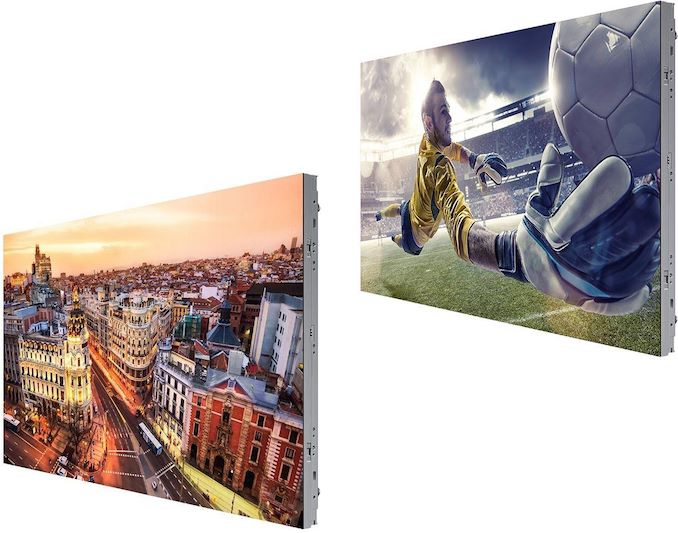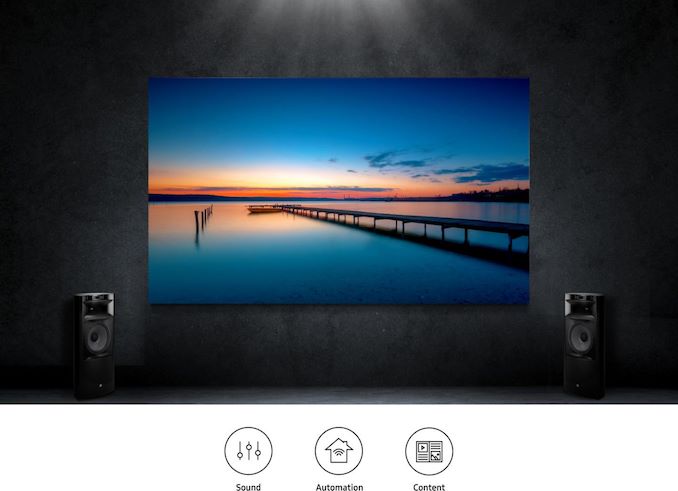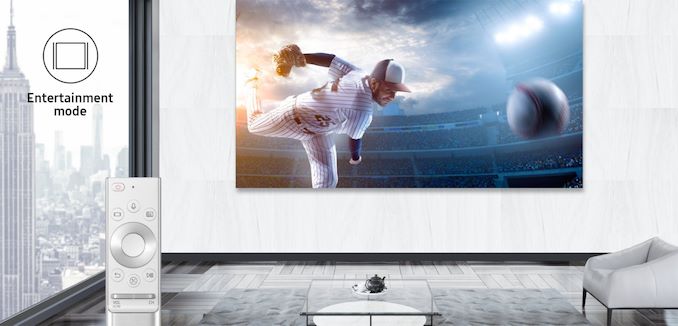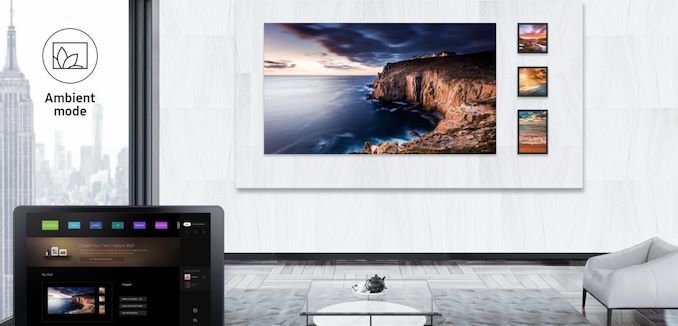Samsung’s Micro LED Wall TVs Now Available: Up to 8K, Up to 292-Inches
by Anton Shilov on October 3, 2019 9:15 AM EST
Samsung has started global sales of its Micro LED-based 'The Wall' display systems. The Wall televisions will be available in multiple configurations, but customized according to individual orders. The most basic Wall will offer a Full-HD resolution as well as a 73-inch size, wheareas the most advanced model will feature an 8K resolution and a 292-inch size.
Samsung’s The Wall televisions (IW008R) rely on the company’s bezel-less 806.4 × 453.6-mm Micro LED cabinets with a 960×540 resolution as well as 0.84-mm² individually-controlled LEDs. The building blocks feature 250 - 2000 nits brightness (regular/peak), around 10,000:1 contrast ratio, a 16-bit color depth, up to a 100/120 Hz refresh rate, as well as 155°/135° horizontal/vertical viewing angles. The modules also feature Samsung’s Black Seal and Ultra Chroma technologies to further improve contrasts and color saturation.
The Wall TVs come with a multimedia box based on Samsung’s Quantum Processor Flex SoC that supports a 20-bit internal processing, AI upscaling, video decoding, various HDR modes (HDR10+, LED HDR), and can run a variety of applications (Bixby, Netflix, YouTube, SmartThings, etc.).
As in case of competing Micro LED-based TVs, resolution of Samsung’s Wall televisions depends on their size. The Full-HD version uses only four cabinets and measures 73 inches in diagonal. By contrast, the 4K Full-HD model relies on 16 modules and therefore measures 146 inches. 6K and 8K Wall TVs feature 219-inch and 292-inch diagonals, respectively. Samsung can build non-standard bespoke Micro LED TVs as well for those who need them.
Samsung does not disclose pricing of its Wall televisions, but asks interested customers to contact it for an individual offering. That said, it is pretty obvious that pricing of Samsung’s Micro LED TVs will be well above MSRP of its ultra-premium QLED 4K or 8K televisions.
Related Reading:
- Sony’s Micro LED-Based Ultra-HD TVs Available to Consumers: 2K to 16K Resolutions, up to 790-Inches
- TCL Shows Off 132-Inch Micro LED 4K UHDTV: 24,000,000 Micro LEDs
- Sony Develops 16K Display: A 783-Inch ‘Crystal LED’ Screen
- Samsung at CES 2019: 219-Inch and 75-Inch Micro LED Ultra-HD TVs Demonstrated
Source: Samsung (via MicroLED-Info.com)














33 Comments
View All Comments
s.yu - Friday, October 4, 2019 - link
This is already better than Sony's.Higher density: 4K@146", which is the perfect size for home theater, vs 220" which many condos don't even fit (2.4-2.7m floor height) and you'll need to move unnecessarily far from the screen to avoid your legs blocking the view.
Higher peak brightness: 1600/2000nit vs. 1000nit.
Higher efficiency: max power consumption of 960x540 module is about the same as Sony's 320x360 module
Lower thickness: 30-72mm vs. 100mm
Lower weight: one 960x540 module is about the same weight as Sony's 320x360 module.
Sony's seems two generations behind.
s.yu - Friday, October 4, 2019 - link
...The price remains an issue though, if this turns out twice Sony's price for a given size then forget the above.dropme - Sunday, October 6, 2019 - link
Why are you so obsessed with Sony.s.yu - Sunday, October 6, 2019 - link
Because Sony's the only other MicroLED competitor, and the only one with pricing information at the moment.daviderickson - Thursday, October 3, 2019 - link
These are insanely gorgeous in person, they had it at CES, and it blew away everything else on the showfloor by a country mile.PeachNCream - Thursday, October 3, 2019 - link
What is a country mile?valinor89 - Thursday, October 3, 2019 - link
I guess a unit of measure used on those "country roads" I heard about in some song...vortmax2 - Thursday, October 3, 2019 - link
A country mile is significantly longer than an urban mile. So this must be one nice TV. LOLKevin G - Thursday, October 3, 2019 - link
Having built and maintained several LED walls from different vendors, these spec aren't that impressive initially. Other panels can be configured up to 600 Hz, 16 bit per channel color, and even higher contrast ratios. I suspect some things are lost when moving from individually surface mounted LEDs on a module to microLEDs packagingThe bigger question is the backend as several cabinets are typically fed by a CAT6A/7 or fiber down link connection from a control box and then daisy changed together. Newer LED controllers from Barco and Christie in fact use encapsulated video over Ethernet (SDVoE to be specific) and connect directly to their respective cabinets. A control box has a maximum number of pixels they can feed for a given refresh so they can feed so more are necessary as aggregate resolution increases. To feed more control boxes, a single input is generally fed into a video processor that'll splice the single image feed into multiple subsections for each control box. If Samsung can consolidate the backend a bit from more traditional LED solutions, that is a strong positive in my book.
It does appear that Samsung is throwing their smart TV product features into their backend controllers. Having Netflix embedded into the backend control boxes is something new for this market as such devices were always seen as external sources before. These are often seen as more consumerish features that get in the way (there is a reason why commercial displays are desirable as relatively 'dumb' TVs). Until prices really reach consumer thresholds, I'd be hesitate on pushing these in a microLED product line.
vortmax2 - Thursday, October 3, 2019 - link
Great post. Thanks for the info on the economics and market.